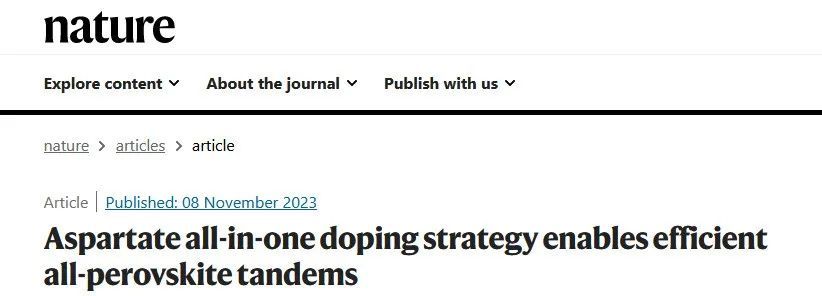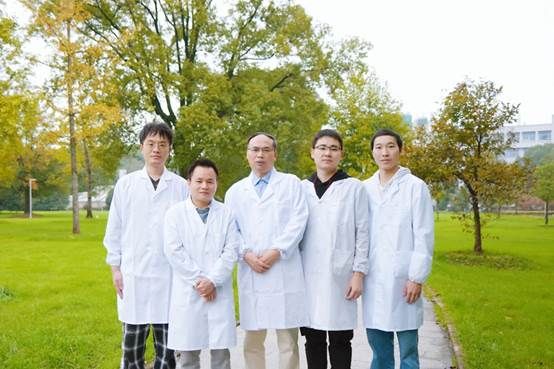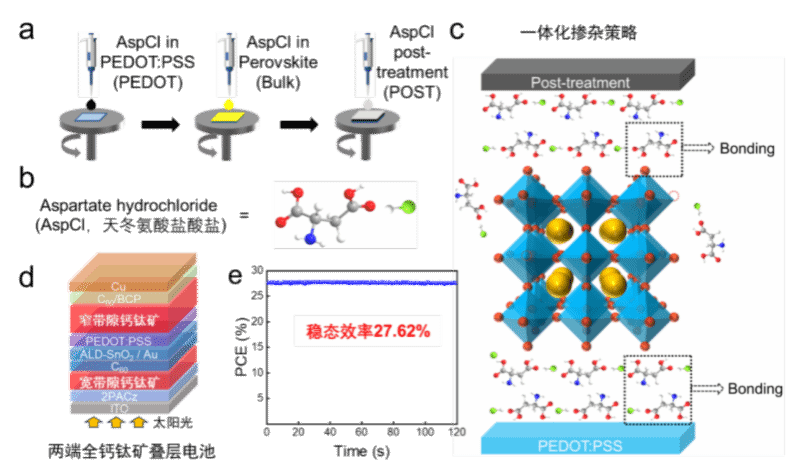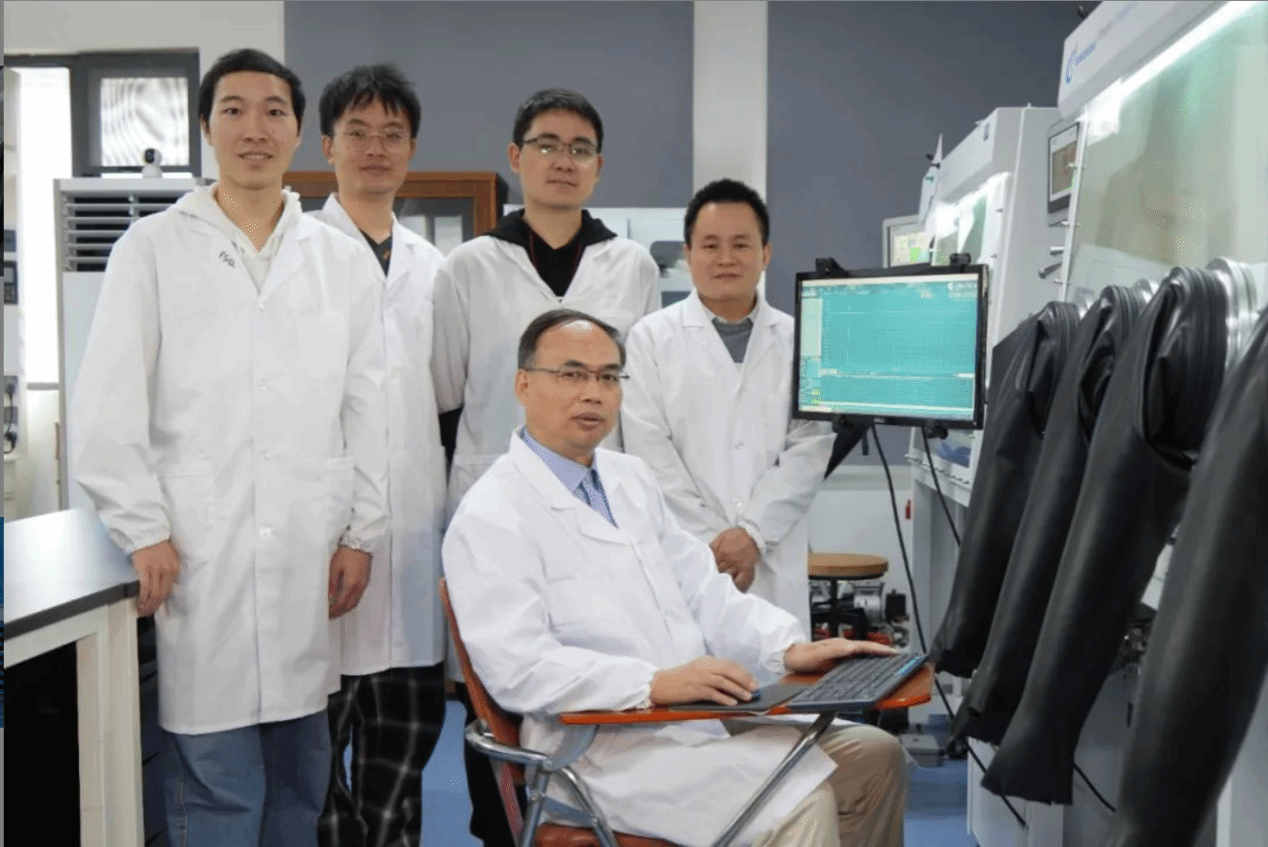On November 8, Nature published online the latest research results on all-perovskite tandem solar cells by the team of Ke Weijun and Fang Guojia from the School of Physics and Technology of Wuhan University. The paper is titled "Aspartate all-in-one doping strategy enables efficient all-perovskite tandems".

Zhou Shun, Fu Shiqiang and Wang Chen, Ph.D., students of the School of Physics and Technology, are the co-first authors of the paper, Prof. Ke Weijun and Prof. Fang Guojia are the corresponding authors, and Researcher Wang Ti, Dr. Meng Weiwei, PhD student Zhou Jin, postgraduate student Lin Qingxian, undergraduate student [1] Zou Yuanrong and others are its co-authors, with Wuhan University listed as the sole affiliation.

▲From right to left: Fu Shiqiang, Zhou Shun, Fang Guojia, Ke Weijun,Wang Chen
The new metal halide perovskite is a crystalline material with the molecular formula ABX3, which has the advantages of a simple preparation process, high defect tolerance, high absorption coefficient, and long carrier diffusion length, etc. It has attracted much attention in the field of photoelectric devices and is considered to be one of the most promising next-generation photovoltaic materials. Among them, the photovoltaic conversion efficiency of single-junction perovskite solar cells has been comparable to that of conventional silicon solar cell[2] s, but it will be increasingly difficult to further improve their efficiency.
All-perovskite tandem solar cells hold great promise in surpassing the Shockley–Queisser limit for single-junction solar cells, with a theoretical efficiency of up to 44% and the performance of which still has significant scope for improvement. All-perovskite tandem solar cells consist of an integrated stack of a wide-bandgap perovskite front cell and a narrow-bandgap perovskite back cell, and the subpar narrow-bandgap perovskite subcells are one of the stumbling blocks to its future commercialization and a common challenge in the field.
In view of this problem, Fang and Ke's team simultaneously improved the efficiency and stability of narrow-bandgap perovskite subcells through an all-in-one aspartate doping strategy, achieving a steady-state efficiency of 27.62% (27.34% certified by a third-party authority), which is one of the world’s highest efficiency for two terminal all perovskite tandem solar cells at present.

In this study, the researchers skillfully introduced aspartate hydrochloride (AspCl) into the bottom hole transport layers, the middle perovskite light-absorbing layers and the top capping layers to develop an integrated doping strategy using the same molecular treatment. It was found that the formation energy of AspCl-SnI2 and AspCl-PbI2 were very low, which facilitated the formation of intermediates or complexes, thus greatly improving the quality of perovskite films. In addition to coordination with perovskites’ precursors, AspCl molecules have strong intermolecular hydrogen bonds and are enriched at the upper and lower perovskite layer interfaces, creating an internal molecular lock between the perovskite layer and the transport layer and further improving the properties and stability of perovskites.
In addition, how to suppress the spontaneous oxidation of Sn2+ in narrow-bandgap perovskites is also a major pain point in the industry. The results show that AspCl can effectively inhibit the oxidation of Sn2+ and reduce the harmful impure Sn4+. Further studies also show that the introduction of AspCl can passivate the defects of perovskite materials, regulate the Fermi level, and contribute to the suppression of harmful ion migration, thus improving the properties and stability of devices. This simple integrated doping strategy produces mutual benefits, providing a promising approach for performance enhancement of narrow-bandgap perovskite and all-perovskite tandem solar cells, and is expected to promote the development of other photovoltaic fields.
This research was supported by the National Natural Science Foundation of China, the Natural Science Foundation of Hubei Province and the Research Public Service Conditional Platform of Wuhan University.

The team of Fang Guojia and Ke Weijun has long been dedicated to the field of novel photoelectric devices, focusing on perovskite solar cells, light-emitting diodes and detectors. In the past three years, their research results have been published in Nature (1), Nature Photonics (1), Nature Communications (1), Advanced Materials (4), Joule (2), Matter (1), Energy & Environmental Science (3), Advanced Functional/Energy Materials (6), ACS nano (1), Science Bulletin (1) and other authoritative journals in the field.
Link to paper: https://www.nature.com/articles/s41586-023-06707-z
Rewritten by Ruan Yawen
Edited by Zhang Ruoxi, Sylvia, Xi Bingqing


